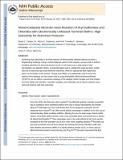Nickel-Catalyzed Mizoroki-Heck Reaction of Aryl Sulfonates and Chlorides with Electronically Unbiased Terminal Olefins: High Selectivity for Branched Products
Author(s)
Tasker, Sarah Z.; Gutierrez, Alicia C.; Jamison, Timothy F.; Tasker, Sarah Zinnen
DownloadJamison_Nickel-catalyzed.pdf (969.8Kb)
OPEN_ACCESS_POLICY
Open Access Policy
Creative Commons Attribution-Noncommercial-Share Alike
Terms of use
Metadata
Show full item recordAbstract
Achieving high selectivity in the Heck reaction of electronically unbiased alkenes has been a longstanding challenge. Using a nickel-catalyzed cationic Heck reaction, we were able to achieve excellent selectivity for branched products (≥19:1 in all cases) over a wide range of aryl electrophiles and aliphatic olefins. A bidentate ligand with a suitable bite angle and steric profile was key to obtaining high branched/linear selectivity, whereas the appropriate base suppressed alkene isomerization of the product. Although aryl triflates are traditionally used to access the cationic Heck pathway, we have shown that, by using triethylsilyl trifluoromethanesulfonate, we can effect a counterion exchange of the catalytic nickel complex, such that cheaper and more stable aryl chlorides, mesylates, tosylates, and sulfamates can be used to yield the same branched products with high selectivity.
Date issued
2014-02Department
Massachusetts Institute of Technology. Department of ChemistryJournal
Angewandte Chemie International Edition
Publisher
Wiley-VCH Verlag GmbH & Co.
Citation
Tasker, Sarah Z., Alicia C. Gutierrez, and Timothy F. Jamison. “Nickel-Catalyzed Mizoroki-Heck Reaction of Aryl Sulfonates and Chlorides with Electronically Unbiased Terminal Olefins: High Selectivity for Branched Products.” Angewandte Chemie International Edition 53, no. 7 (January 8, 2014): 1858–1861.
Version: Author's final manuscript
ISSN
14337851